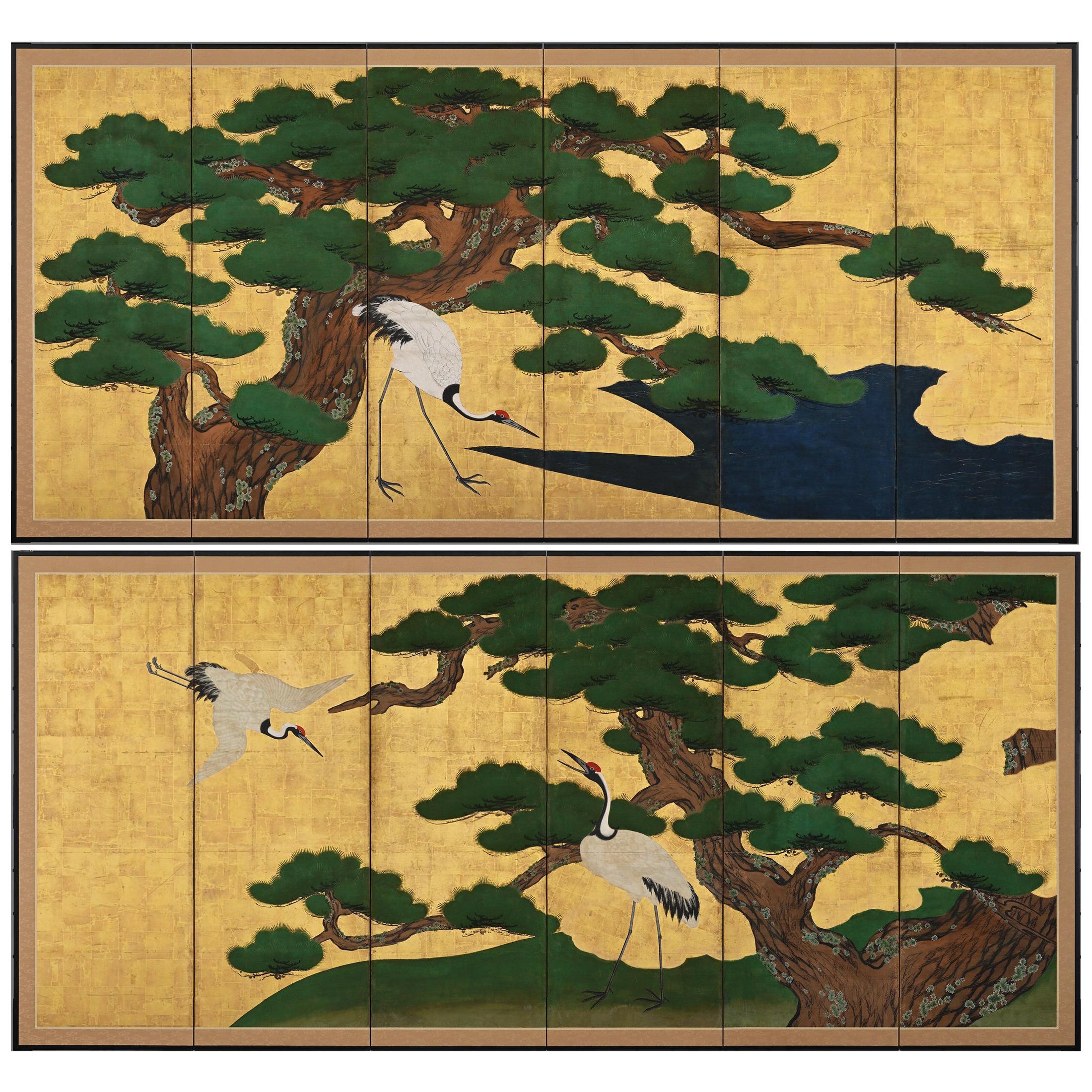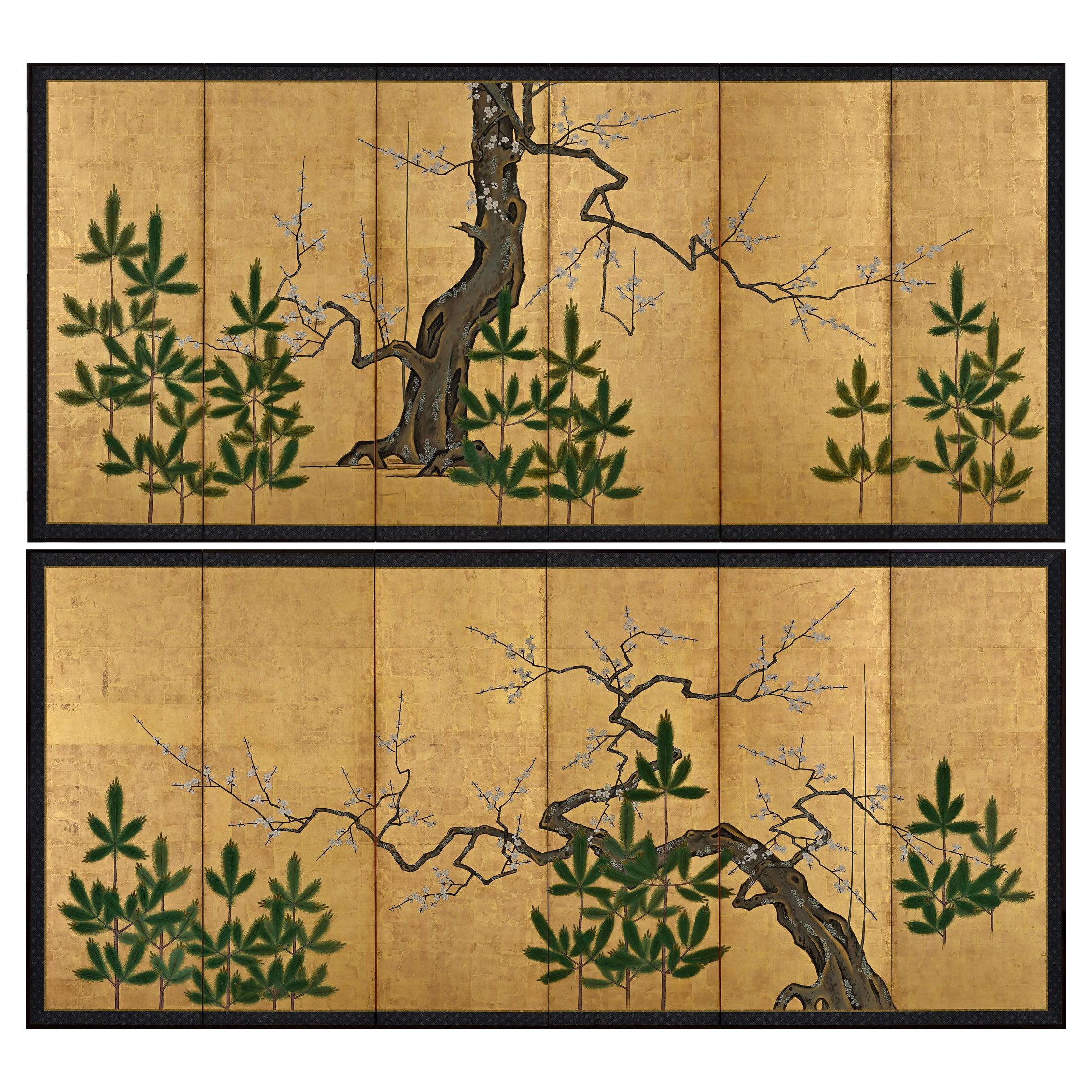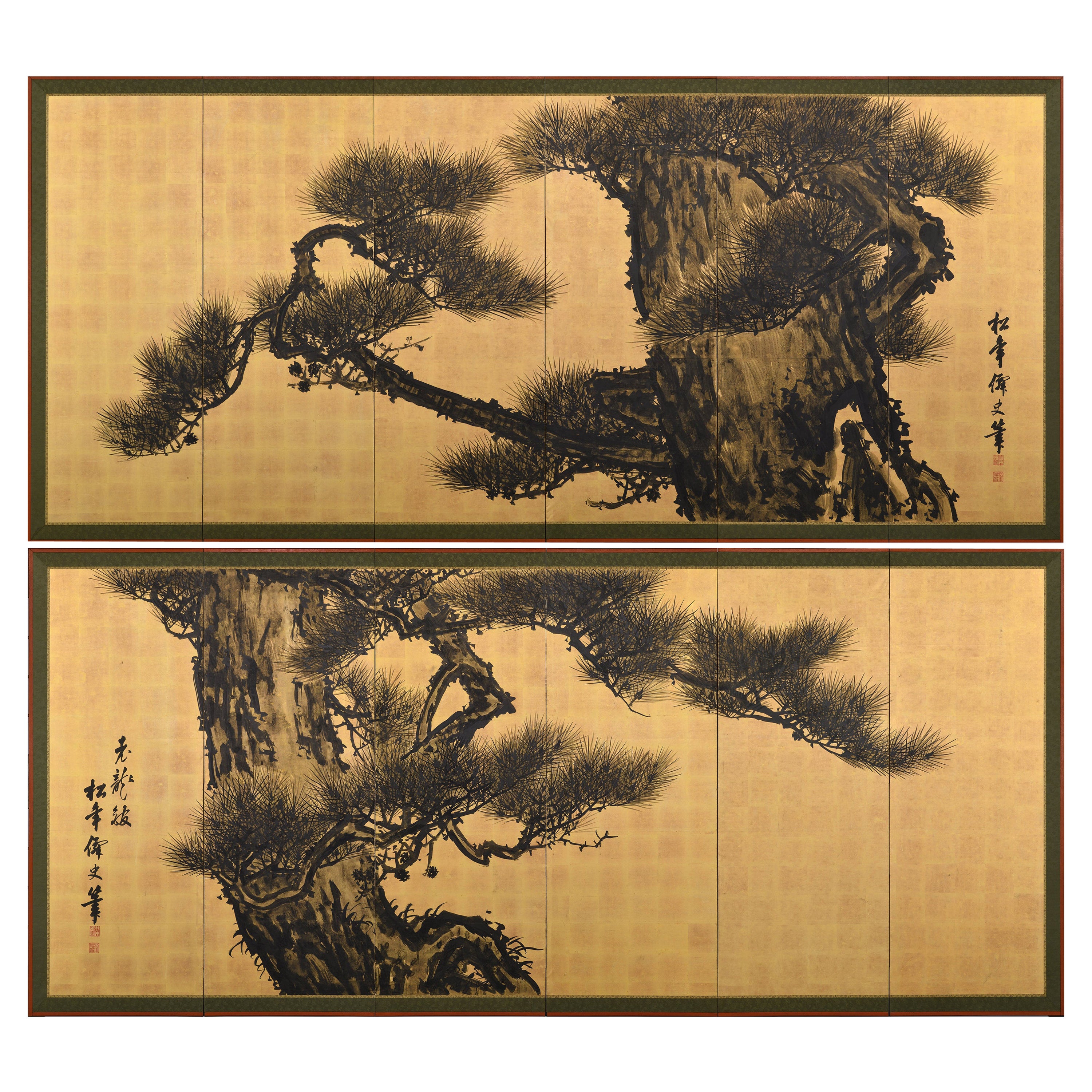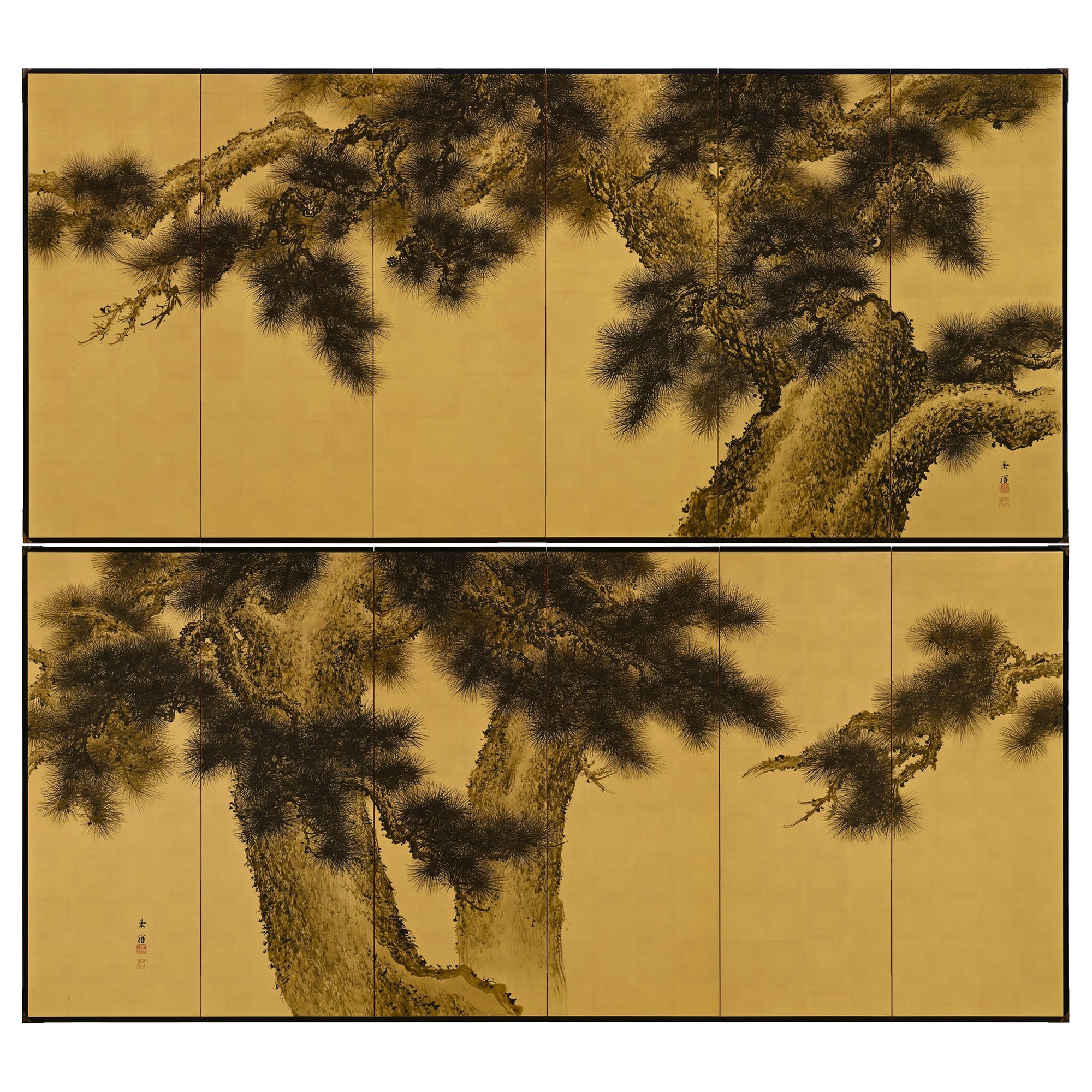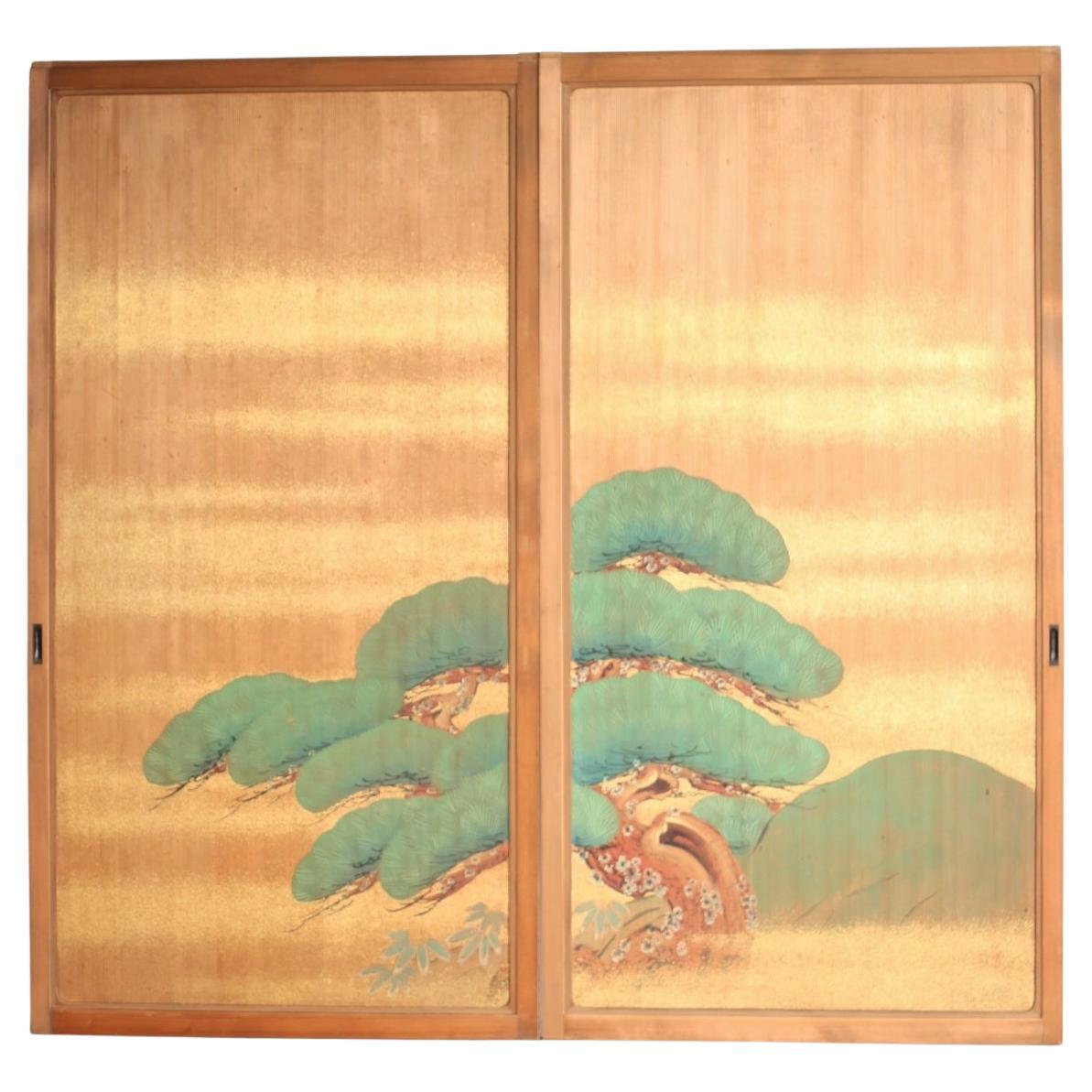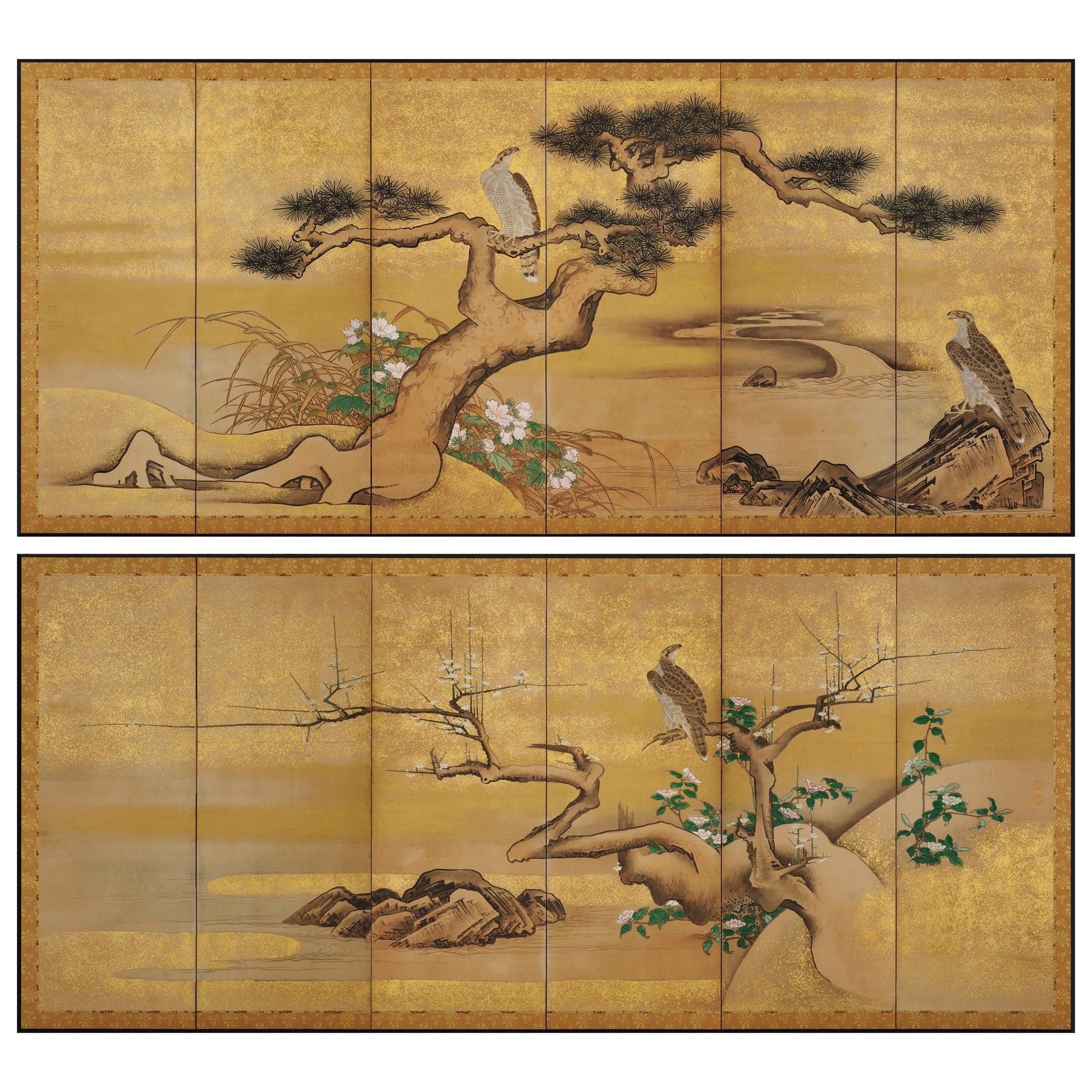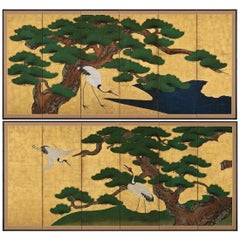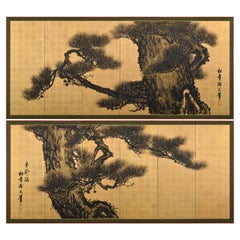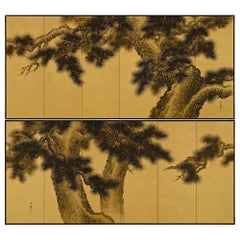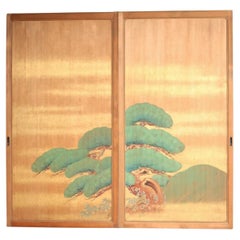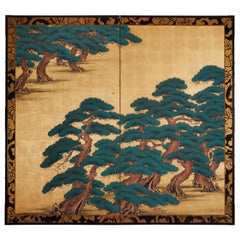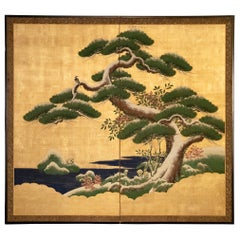Items Similar to Circa 1700 Japanese Sliding Door (Fusuma) Set. Pine Trees on the Seashore.
Want more images or videos?
Request additional images or videos from the seller
1 of 6
Circa 1700 Japanese Sliding Door (Fusuma) Set. Pine Trees on the Seashore.
$45,000per set
£34,116.18per set
€39,326.94per set
CA$63,375.28per set
A$70,278.50per set
CHF 36,926.14per set
MX$858,683.80per set
NOK 461,996.35per set
SEK 433,662.51per set
DKK 293,583.29per set
About the Item
"Pine Trees on the Seashore"
A set of four sliding doors (Japanese fusuma). Ink, color, gold-leaf and gold-fleck on paper.
Dimensions (total display size - 4 doors): H. 173 cm x 385 cm (68” x 151.5”)
Japanese screens and sliding doors adorned with windswept pine trees scattered across sandy beaches, separated by elegantly flowing ocean waves, are a hallmark of traditional Yamato-e painting. Yamato-e is a style of painting that emerged in Japan and focused on distinctly Japanese themes and aesthetics rather than imitating Chinese models. Yamato-e often emphasizes narrative elements, seasonal changes, and delicate details that evoke a deep connection with nature.
This particular motif, known as Hamamatsu-zu (浜松図), or ‘Pine Trees on the Seashore’, belongs to the Meisho-e (名所絵) genre, which translates to "pictures of famous places." Meisho-e paintings often depicted celebrated landscapes, seasonal scenes, or culturally significant locations in Japan. These sliding doors and folding screens served both artistic and functional purposes, transforming interiors into immersive landscapes. These surfaces, in particular sliding doors, allowed art to become part of the living environment, blending daily life with artistic expression.
Historical records indicate that the seashore was sometimes depicted in "pictures of famous places” of the Heian period, such as the coast of Suminoe (住之江), Ise (伊勢, Mie Prefecture), or Setsu (摂津, Hyōgo Prefecture). It seems likely that there was little variation in the coastal scenes depicted in these Heian famous view paintings because none of them were painted from life. None of the hamamatsu-zu paintings created before the 15th century have survived. However, several horizontal hand-scrolls from that era have survived to this day. These scrolls contain miniature images of painted screens, including those with pictures of the shore and pine trees. These screens depict scenes of wide open seas and stylized waves lapping against a sandy, flat shore lined with majestic pine trees. The earliest and most renowned surviving example of a pair of screens depicting pine trees, the ocean and boats dates to the Muromachi period, 15th century. These are an Important Cultural Property of Japan and held in the Tokyo National Museum. Based on these models and others like them, the theme, with gradual variation over time, continued to be represented in Japanese art until well into the Edo period.
This particular set of sliding doors is a fine example of the theme from the late 17th or early 18th centuries, circa 1700. The pine trees in this painting are depicted in a windswept, dynamic manner. Their twisted, tall forms contribute a sense of movement and energy, creating a stark contrast with the smooth, undulating lines of the ocean. This dynamic tension between the solidity of the trees and the fluidity of the sea reflects nature’s constant interplay. The gently repetitive forms of the waves not only serve to divide the composition but also guide the viewer’s eye across the scene, creating a rhythmic flow that mirrors the natural ebb and flow of the tides. The foreground features abstracted fishing boats jutting into the waves, their angular shapes adding depth and movement to the painting. These boats not only enhance the maritime theme but also hint at the livelihoods of coastal communities, subtly weaving human presence into the vast natural scenery. The interplay of land, sea, and sky, accentuated by the gold-leaf background and misty atmospheric effects, creates a harmonious and dreamlike vision of Japan’s coastal beauty.
- Dimensions:Height: 68 in (172.72 cm)Width: 151.5 in (384.81 cm)Depth: 0.75 in (1.91 cm)
- Sold As:Set of 4
- Style:Edo (Of the Period)
- Materials and Techniques:
- Place of Origin:
- Period:Late 17th Century
- Date of Manufacture:Circa 1700
- Condition:Refinished. Wear consistent with age and use. The sliding doors have recently been fully restored and remounted.
- Seller Location:Kyoto, JP
- Reference Number:1stDibs: LU2472344066822
About the Seller
5.0
Recognized Seller
These prestigious sellers are industry leaders and represent the highest echelon for item quality and design.
Established in 2001
1stDibs seller since 2016
72 sales on 1stDibs
Typical response time: 16 hours
- ShippingRetrieving quote...Shipping from: Kyoto, Japan
- Return Policy
Authenticity Guarantee
In the unlikely event there’s an issue with an item’s authenticity, contact us within 1 year for a full refund. DetailsMoney-Back Guarantee
If your item is not as described, is damaged in transit, or does not arrive, contact us within 7 days for a full refund. Details24-Hour Cancellation
You have a 24-hour grace period in which to reconsider your purchase, with no questions asked.Vetted Professional Sellers
Our world-class sellers must adhere to strict standards for service and quality, maintaining the integrity of our listings.Price-Match Guarantee
If you find that a seller listed the same item for a lower price elsewhere, we’ll match it.Trusted Global Delivery
Our best-in-class carrier network provides specialized shipping options worldwide, including custom delivery.More From This Seller
View AllCirca 1700 Japanese Screen Pair, Cranes & Pines, Kyoto Kano School
Located in Kyoto, JP
Pines and Cranes
Anonymous. Kyoto Kano School.
Late 17th/early 18th centuries, circa 1700.
Pair of six-panel Japanese folding screens.
Ink, gofun, pigment and gold leaf on paper.
This bold composition presents two pine trees extending to the left and right across a gold leaf background. One tree is silhouetted against a green ground, golden clouds obscuring its true size, the other stretches across a stylized waterway. The pines are paired with Manchurian cranes with red crests and snow white plumage. Both have been highly auspicious motifs in East Asia since Chinese antiquity. Here the artist utilized fluid and instinctive ink brushstrokes to define the trunk, branches and tail feathers, in strong contrast to the precision and sharp angularity of the crane’s legs and beaks. The adoption of this vast metallic painting support required an unerring sense of design and composition, so that the negative space surrounding motifs could imply context for the otherwise floating pictorial elements. The brushwork detailing the trunks of the pines, the exaggerated dimensions of the pine trees and the strength and dynamism of the composition are all reminiscent of Kano Eitoku...
Category
Antique Late 17th Century Japanese Edo Paintings and Screens
Materials
Gold Leaf
18th Century Japanese Screen Pair. Plum & Young Pines. Kano School.
Located in Kyoto, JP
Dimensions (Each screen): H. 176 cm x W. 378 cm (69’’ x 149’’)
This pair of Japanese folding screens depict blossoming plum trees amongst young pines. They are designed to capture t...
Category
Antique Late 18th Century Japanese Edo Paintings and Screens
Materials
Gold Leaf
Circa 1900 Japanese Pine Screen Pair. Aged Dragons by Suzuki Shonen.
Located in Kyoto, JP
Suzuki Shonen (1848-1918)
Aged Dragons
A pair of six-panel Japanese screens. Ink and gold leaf on paper.
Dimensions: Each Screen: H. 170 cm x 378 cm (67" x 149")
As with the pair...
Category
Early 20th Century Japanese Meiji Paintings and Screens
Materials
Gold Leaf
Early 20th Century Japanese Screen Pair - Ink Pine Trees on Gold
Located in Kyoto, JP
Imao Keisho (1902-1993)
Pine Trees
Early 20th Century, Circa 1930
Pair of six-panel Japanese screens. Ink on silk and gold leaf.
Dimensions: Each screen H. 67.5” x 148” (172 cm x 376 cm)
A pair of monumental six-panel Japanese pine screens by the renowned Nihonga artist Imao Keisho. Here Keisho entirely removed the background and brought the pine trees to the surface of the painting. This simplification of the elements makes the scene exceptionally direct and compelling and injects a very modern...
Category
Early 20th Century Japanese Showa Paintings and Screens
Materials
Gold Leaf
17th Century Japanese Screen Pair by Soga Nichokuan, Hawks on Pine & Plum Trees
Located in Kyoto, JP
Hawks on plum and pine
Soga Nichokuan (active circa 1625-1660)
Pair of six-fold screens.
Ink, mineral pigments, gofun, gold and speckled gold l...
Category
Antique 1640s Japanese Edo Paintings and Screens
Materials
Wood, Paper
17th Century Japanese Screen. View of West Lake by Unkoku Toyo.
Located in Kyoto, JP
Unkoku Toyo (1612-1668)
View of West Lake
Pair of eight-panel Japanese Screens. Ink and gold wash on paper.
Dimensions: Each screen: H. 110 cm x W. 372 cm (43” x 147”)
This pair ...
Category
Antique Mid-17th Century Japanese Edo Paintings and Screens
Materials
Paper
You May Also Like
Japanese Antiques Pine Trees, Panel Painting/Sliding Door Painting, 2 Pieces set
Located in Niiza, JP
The material is thought to be cedar or cypress.
925 (W) x 1775 (H) x 30 (D) [mm] *Size of one piece 7㎏/per
Estimate packing size 35kg L18cm W105cm H190cm
The color is well preserve...
Category
20th Century Japanese Paintings and Screens
Materials
Wood
Japanese Two Panel Screen: Pine on Heavy Gold
Located in Hudson, NY
Kano School painting in mineral pigments on mulberry paper with heavy gold leaf and a silk brocade border made of antique monk's robes.
Category
Antique Late 19th Century Japanese Paintings and Screens
Materials
Gold Leaf
Japanese Two Panel Screen: Pine in Snow
Located in Hudson, NY
Kano School, Mineral pigments on gold leaf with silk brocade border and lacquer wood trim.
Category
Antique Mid-19th Century Japanese Paintings and Screens
Materials
Gold Leaf
Antique 19th Century Japanese Two-Panel Screen ‘Byobu’, Kano School, Edo Period
Located in London, GB
Japanese Kano School Edo period two-panel screen depicting flowering prunus and bamboo on a rock formation, with colorful birds next to a body of water. ...
Category
Antique Mid-19th Century Japanese Edo Paintings and Screens
Materials
Gold Leaf
Japanese Six Panel Screen, Ancient Pines on the Shore under Silver Moon
Located in Hudson, NY
Venerable pine trees supported and cared for by temple Arborists. Artist signature reads: Koka Sugibayashi. Meiji period painting (1868-1912) in mineral pigments on silk with a silk ...
Category
Antique Early 1900s Japanese Meiji Paintings and Screens
Materials
Silk
Japanese 17th Century Two Panel Screen, Pine with Gold Dust
Located in Hudson, NY
Beautiful 17th century painting of pine trees. Painting in good condition on 19th century mounting. Mineral pigments and gold dust on mulberry paper w...
Category
Antique 17th Century Japanese Edo Paintings and Screens
Materials
Paper
More Ways To Browse
Japanese Doors
Sliding Antique Doors
Antique Sliding Doors
Form And Surfaces Doors
Japanese Weaving
Japanese Boat
Japanese China Set
Japanese Art Ocean
Painting Antique Pine Furniture
Used Screen Doors
Antique Folding Doors
Antique Furniture Tokyo
Japanese Sliding Doors
Japanese Hand Mirror
Antique Japanese Mirrors
Japanese Screen Tree
Pair Of Tall Antique Doors
Antique Ink Well Set
